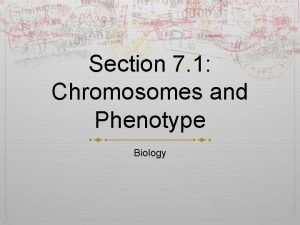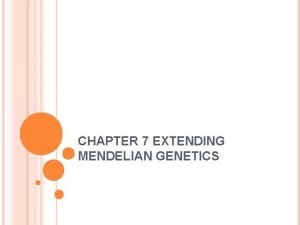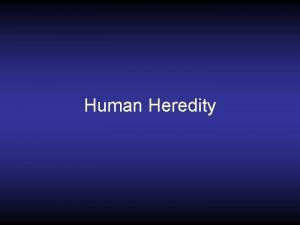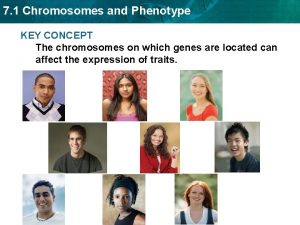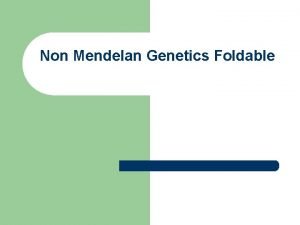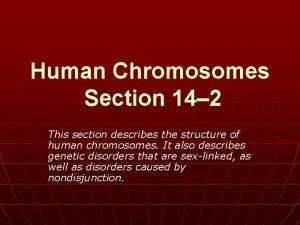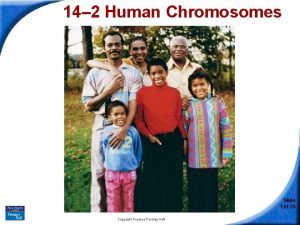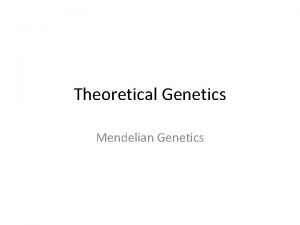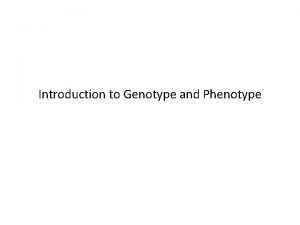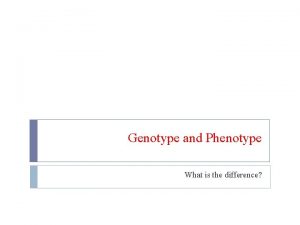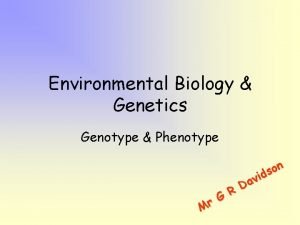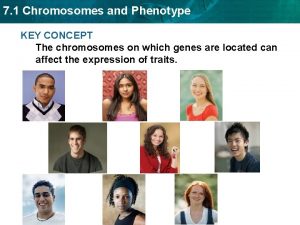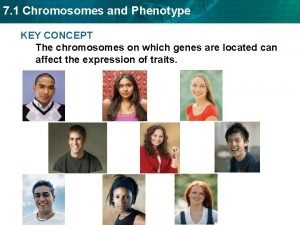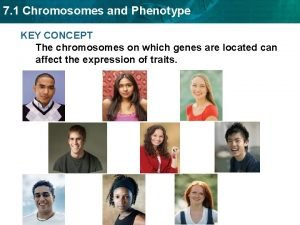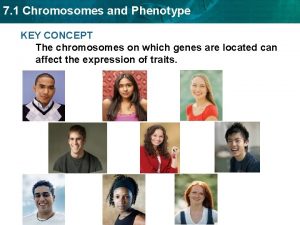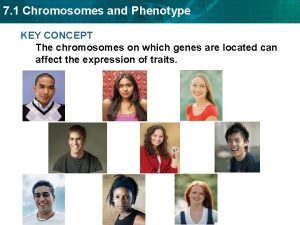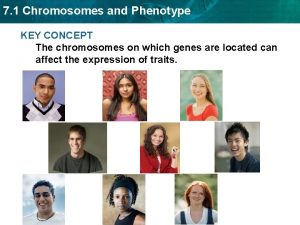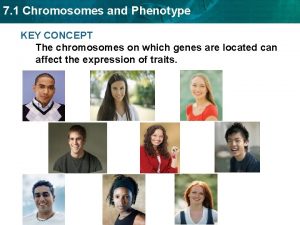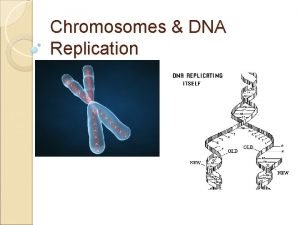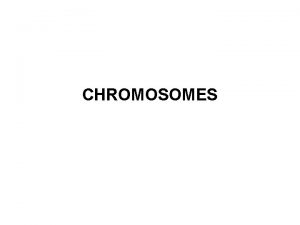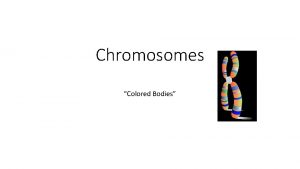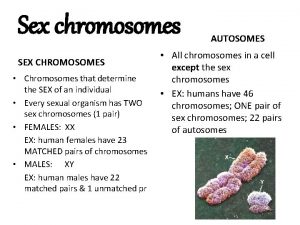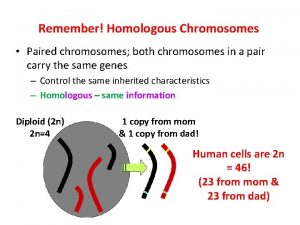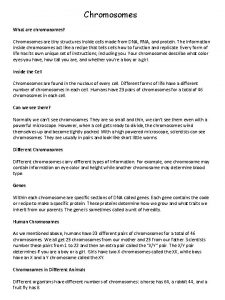7 1 Chromosomes and Phenotype KEY CONCEPT The



















- Slides: 19

7. 1 Chromosomes and Phenotype KEY CONCEPT The chromosomes on which genes are located can affect the expression of traits.

7. 1 Chromosomes and Phenotype Two copies of each autosomal gene affect phenotype. • Mendel studied autosomal gene traits, like hair texture.

7. 1 Chromosomes and Phenotype • Mendel’s rules of inheritance apply to autosomal genetic disorders. – A heterozygote for a recessive disorder is a carrier. – Disorders caused by dominant alleles are uncommon. (dominant)

7. 1 Chromosomes and Phenotype Males and females can differ in sex-linked traits. • Genes on sex chromosomes are called sex-linked genes. – Y chromosome genes in mammals are responsible for male characteristics. – X chromosome genes in mammals affect many traits.

7. 1 Chromosomes and Phenotype • Male mammals have an XY genotype. – All of a male’s sexlinked genes are expressed. – Males have no second copies of sex-linked genes.

7. 1 Chromosomes and Phenotype • Female mammals have an XX genotype. – Expression of sex-linked genes is similar to autosomal genes in females. – X chromosome inactivation randomly “turns off” one X chromosome.

7. 1 Chromosomes and Phenotype KEY CONCEPT Phenotype is affected by many different factors.

7. 1 Chromosomes and Phenotype can depend on interactions of alleles. • In incomplete dominance, neither allele is completely dominant nor completely recessive. – Heterozygous phenotype is intermediate between the two homozygous phenotypes – Homozygous parental phenotypes not seen in F 1 offspring

7. 1 Chromosomes and Phenotype • Codominant alleles will both be completely expressed. – Codominant alleles are neither dominant nor recessive. – The ABO blood types result from codominant alleles. • Many genes have more than two alleles.

7. 1 Chromosomes and Phenotype Many genes may interact to produce one trait. • Polygenic traits are produced by two or more genes. Order of dominance: brown > green > blue.

7. 1 Chromosomes and Phenotype • An epistatic gene can interfere with other genes.

7. 1 Chromosomes and Phenotype The environment interacts with genotype. • Phenotype is a combination of genotype and environment. • The sex of sea turtles depends on both genes and the environment • Height is an example of a phenotype strongly affected by the environment.

7. 1 Chromosomes and Phenotype KEY CONCEPT A combination of methods is used to study human genetics.

7. 1 Chromosomes and Phenotype Human genetics follows the patterns seen in other organisms. • The basic principles of genetics are the same in all sexually reproducing organisms. – Inheritance of many human traits is complex. – Single-gene traits are important in understanding human genetics.

7. 1 Chromosomes and Phenotype Females can carry sex-linked genetic disorders. • Males (XY) express all of their sex linked genes. • Expression of the disorder depends on which parent carries the allele and the sex of the child. Y X

7. 1 Chromosomes and Phenotype A pedigree is a chart for tracing genes in a family. • Phenotypes are used to infer genotypes on a pedigree. • Autosomal genes show different patterns on a pedigree than sex-linked genes.

7. 1 Chromosomes and Phenotype • If the phenotype is more common in males, the gene is likely sex-linked.

7. 1 Chromosomes and Phenotype Several methods help map human chromosomes. • A karyotype is a picture of all chromosomes in a cell. XY

7. 1 Chromosomes and Phenotype • Karyotypes can show changes in chromosomes. – deletion of part of a chromosome or loss of a chromosome – large changes in chromosomes – extra chromosomes or duplication of part of a chromosome
 Section 1 chromosomes and phenotype
Section 1 chromosomes and phenotype Section 1 chromosomes and phenotype
Section 1 chromosomes and phenotype Extending mendelian genetics
Extending mendelian genetics Section 1 chromosomes and phenotype
Section 1 chromosomes and phenotype Xyy male syndrome
Xyy male syndrome Genetics foldable
Genetics foldable Chapter 4 lesson 4 metamorphic rocks answer key
Chapter 4 lesson 4 metamorphic rocks answer key Key concept builder lesson 1 what are waves answer key
Key concept builder lesson 1 what are waves answer key 14-2 human chromosomes
14-2 human chromosomes 14-2 human chromosomes
14-2 human chromosomes Key activities canvas
Key activities canvas Contoh bisnis model canvas makanan pdf
Contoh bisnis model canvas makanan pdf Sickle cell anemia genotype and phenotype
Sickle cell anemia genotype and phenotype Blood type punnet square
Blood type punnet square Hh h hh punnett square
Hh h hh punnett square Phenotype
Phenotype Genotype and phenotype ratio
Genotype and phenotype ratio Phenotype and genotype
Phenotype and genotype Heterozygous example
Heterozygous example Genotype and phenotype
Genotype and phenotype
